Discussion Questions
DQ 2-1
After the core of an ERP system has been implemented, any of the modules may then be implemented separately. What is the implication of being able to implement an ERP system on a piece-by-piece basis?
ANS. An advantage of being able to implement individual modules is that you can choose best-of-breed software.Also, a partial implementation can be done more quickly and the benefits received earlier. The remainder of the implementation can proceed as needed and as resources permit.
Adisadvantage might be that you may not experience the benefits of full integration and may need to create links between modules from different vendors.
DQ 2-2
The Tigris Company is considering taking customers’ orders on its Web site.
a. What information would Tigris collect from the customer during this process?
b. What information would need to come from Tigris’ Web and back-end systems to complete the order?
c. How would an enterprise system facilitate this exchange of information?
ANS.
a. Collect customer number or name. If this is not an existing customer, Bluffs would need customer address, contact information, and so on. Bluffs would also need to collect the product codes and quantities that the customer is ordering.
b. Information needed may include open orders, previous orders (for preferences), credit status, requested item availability and promised delivery date, ship-to address, and bill-to address.
c. An enterprise system makes this process timely and seamless. The customer would not see or experience problems related to the collection and display of this data.Although this would be true of well-integrated legacy systems, an enterprise system should be able to exchange more information with a Web server in a timelier manner and with a higher level of data integrity.
© 2018 Cengage®. May not be scanned, copied or duplicated, or posted to a publicly accessible website, in whole or in part, except for use as permitted in a license distributed with a certain product or service or otherwise on a password-protected website or school-approved learning management system for classroom use.
DQ 2-3
Periodically, you will read in the news about one company in the ERP industry acquiring another company in that industry. Discuss the pros and cons of consolidation of the ERP software industry.
ANS. Pros include enhanced functionality of individual products as vendors incorporate the features of several products into one.An organization can do one-stop shopping for multiple packages with one vendor. This should lead to fewer problems when integrating different vendors’products. Large vendors are presumably more stable than the smaller, acquired vendors that would have been on their own.
Cons include limited ability to shop and compare among competing products.An ERP system has limited capability to distinguish an organization from others in the industry (i.e., every player in an industry uses the same package).
DQ 2-4
Describe how an enterprise system can assist an organization in optimizing its value system.
ANS. In general, an enterprise system provides data from across an organization’s functions and permits optimal planning and decision making. For example, by providing worldwide visibility of inventory balances, as well as customer and vendor data, orders from customers can be sourced in a way that balances purchasing (and possibly manufacturing) costs with shipping costs while considering the value provided by making the sale and retaining customer good will.
The enterprise system should also be able to exchange data with trading partners to obtain the benefits of sharing information and planning with business partners upstream and downstream in the value system. For example, buyers in one organization can give advance notice of planned purchases so that upstream vendors can plan shipments to the customer.
DQ 2-5
Consider a business process that you have experienced at work, as a customer, or as a student. Examples might include any process in a work setting, such as payroll and purchasing, or any process with which you have interacted, such as ordering from a Web site, obtaining a loan, eating at a restaurant, or registering for classes at your college or university. Describe the degree to which the steps in the process are integrated. What is/was the impact of that integration on you and on the organization?
ANS. The purpose of this question is to get students to appreciate the impact of process integration, or lack thereof, on organization employees, customers, and students. The students might cite such issues as waiting time, re-entry of data, errors, and the interdepartmental communication. One example of integration that students may have experienced is the connection between student accounts, where their tuition and other fees and payments are recorded, and the college/university registration system. This integration should prevent students with overdue accounts from registering for courses.
© 2018 Cengage®. May not be scanned, copied or duplicated, or posted to a publicly accessible website, in whole or in part, except for use as permitted in a license distributed with a certain product or service or otherwise on a password-protected website or school-approved learning management system for classroom use.
DQ 2-6
Describe a situation in which information would be shared between two of the “silos” in Figure 2.2. What data would be shared? Why would the data be shared? (Hint: You may want to refer to Figures 2.3, 2.7, or 2.10 in the text.)
ANS. This solution includes only a few examples. The experience and background of the students will dictate the quantity and nature of their responses:
Finance and accounting must share accounting data about outstanding accounts receivable and payment history with marketing and sales to determine the creditworthiness of the customer before an order could be accepted by the sales system.
Logistics needs to provide marketing and sales with current inventory balances and the time to pick, pack, ship, and deliver the goods so that the customer can be informed as to the expected delivery date.
To establish a production schedule, production requires data from purchasing about the availability of materials from vendors.
Atreasurer must have information about expected purchases, open purchase orders, open vendor invoices (accounts payable), expected sales, open sales orders, and open customer invoices (accounts receivable) to project cash flows.
Marketing must have information from purchasing and manufacturing to establish prices.
Logistics must have sales information by geographic region to plan for new warehouse facilities.
DQ 2-7 Why might a firm decide to implement only certain modules in an ERP system rather than a complete implementation?
ANS. Discussion of this question should begin with recognition of the complexity of ERP systems and the difficulty and time required for a full-blown implementation. Many organizations will decide to implement a few modules to solve major problems or challenges that already exist.After initial modules are in place, a company will make the decision whether to implement further modules immediately, later, or perhaps not at all. Partial implementations, of course, sacrifice some level of integration of the total organizational information process. Also, some organizations may not need all of the modules (e.g., a retailer would not need the manufacturing module).
DQ 2-8 In what circumstances would a company choose a best-of-breed approach over a traditional ERP system?
© 2018 Cengage®. May not be scanned, copied or duplicated, or posted to a publicly accessible website, in whole or in part, except for use as permitted in a license distributed with a certain product or service or otherwise on a password-protected website or school-approved learning management system for classroom use.
ANS Acompany would choose a best-of-breed approach if their process is nonstandard, and available third party software provides a significantly better method of handling that process. The company would need to have internal (or external) technical capability to integrate and support upgrades of the individual components of their best-of-breed system.
DQ 2-9
Describe the primary and supporting activities involved in an organization’s value chain. Explain the importance of having an effective value chain.
ANS: A value chain is a series of activities, or business processes, performed by an organization to transfer inputs into outputs valued by customers. Primary activities include those directly involved in marketing, selling, producing, and delivering goods and services to the customer. Secondary activities include functions such as procurement, IT, human resources, and accounting, and they provide the supporting infrastructure to enable to primary activities. A value chain turns these individual activities into an integrated business process. An effective value chain is very important because an organization increases its competitive advantage in the marketplace by providing the most value to customers.
Short Problems
SP2-1
ANS. Who: Information identifying the customer and the salesperson.
What: Information identifying the inventory items and quantities ordered.
Where: Information identifying which warehouse will supply the goods and where the salesperson entered the order. We also want to know where the customer wants the order delivered.
When: Information identifying the date and time that the order was placed and that the warehouse and shipping department were notified of the pending order fulfillment. We also need to know when the customer requires delivery.
SP2-2
ANS. More data is available to be easily linked together and used to create information in enterprise systems. On that premise, we offer the following examples: (1) A warehouse manager has the ability to look at sales orders that have not yet been shipped to follow up and find out why. Without an integrated enterprise system, the manager may not have access to this information and therefore would not know that there may be a problem. Enterprise systems allow for early detection of potential problems, which may prevent customer dissatisfaction. (2) The credit manager may want to compare customer credit limits with sales, billing, and payment data to determine whether credit limits need to be adjusted. If a customer has a habit of making late payments, the organization may need to evaluate
© 2018 Cengage®. May not be scanned, copied or duplicated, or posted to a publicly accessible website, in whole or in part, except for use as permitted in a license distributed with a certain product or service or otherwise on a password-protected website or school-approved learning management system for classroom use.
whether his credit limit needs to be lowered until outstanding balances are settled. Without the ability to compare all of this linked information, the company could be extending credit to customers that will ultimately become uncollectible. Enterprise systems allow decision makers to proactively reduce unnecessary expenses. (3) A logistics manager may examine the time of day orders are received and delays in shipping those orders to determine whether staffing in the warehouse needs to be scheduled at different times. With a nonintegrated system, the manager may not be able to compare this information and may choose to overstaff during “down” times and understaff when employees are needed to receive deliveries. Examining this data allows for the most efficient use of the organization’s resources because adequate staffing is made available when work is available.
SP2-3 ANS. An example of a business event is a clothing store (e.g., Gap) selling a shirt over the Internet. Its enterprise system allows data sharing across the many business processes that must occur to complete the sale. The company may automatically access its warehouse database to determine whether or not the item is in stock or back-ordered. Once the customer enters his shipping/billing information, the database can automatically determine shipping costs and expected delivery date. The billing information is verified by the accounting process, so the customer is charged immediately. The shipping department receives the order details and can process the request for immediate shipping. Without an enterprise system, all of this data could not be shared throughout the organization, and the selling process would be delayed.
Similarly, an example of a business (purchase) event is an electronics store (e.g., Best Buy) purchasing inventory from manufacturers. The inventory manager has access to databases that provide him information about inventory quantities. When he sees that there are items that are low in quantity, he prepares a purchase order. Purchase orders must be approved by appropriate personnel before they can be placed. The system will look up the purchasing limit of the individual placing the order and check to ensure that the amount does not exceed that limit. The company can then access its vendor database to determine which vendors can supply the inventory at the lowest price. Once the purchase order is approved and processed, the information is updated to the accounting system so that the records reflect this purchase and payment can be made. Without sharing all of this data, managers of different departments may not know what items are close to being out-of-stock and need to be ordered. It is crucial to have sufficient inventory to maintain a competitive advantage and keep customers from shopping elsewhere.
SP 2-4
ANS.
The overall benefit of an enterprise system is the connectivity of modules and the capability to bring related data together in one system. While extracting data from an enterprise system may be complex, for a forensic accountant that complexity is MUCH lower than extracting data from disparate systems then pulling the data together to look for anomalies. In the example given, one could look at sales throughout a region over time and see that only one unit had sales after closing (it might be possible that seasonally, the standard closing time changes
© 2018 Cengage®. May not be scanned, copied or duplicated, or posted to a publicly accessible website, in whole or in part, except for use as permitted in a license distributed with a certain product or service or otherwise on a password-protected website or school-approved learning management system for classroom use.
and late sales are not uncommon.) If each store had its own system, then the data would have to be combined to see the pattern that is inconsistent with the others. Unless suspecting the issue, the investigator may not have any reason to go to the trouble of combining the data, and therefore overlook the issue. In general, the enterprise system makes it easier to analyze data occurring throughout the organization.
Problems
P2-1 ANS. Students should find one or more of the ERP disaster stories such as those that occurred at Hershey, FoxMeyer, and Whirlpool. In addition, they should find stories related to successful ERP implementations such as Indian Motorcycle Company ofAmerica and Cisco Systems, Inc. Factors leading to successful or failed implementations might include the following:
Allocation of adequate resources (people and money)
Sponsorship and monitoring by upper management
Realistic timeline
Fully defined system requirements
Organization culture that embraces change
Synchronization of business processes with ERP functionality (perhaps reengineering) before ERP implementation
Managing the risk of implementation failure
Adequate testing before implementation
Training for all who will use the ERP
P2-2 ANS. Because student responses will depend on the package that they select, no solution is provided for this problem.
P2-3 ANS. Because student responses will depend on the package that they select, no solution is provided for this problem.
P2-4 ANS. Expect students to include steps similar to those included in this chapter, including the following:
Step 1: Acustomer can log on to a Web site and perform inquiries as to price and availability of items. The Web site might perform presales activities such as collecting and retaining customer (or prospective customer) data.
Step 2: The customer enters his or her own order, and the Web site notifies the customer as to availability and expected delivery date. In addition, the customer enters credit card data.
Step 3: The pick and pack steps are probably transparent when purchasing from a Web merchant.
© 2018 Cengage®. May not be scanned, copied or duplicated, or posted to a publicly accessible website, in whole or in part, except for use as permitted in a license distributed with a certain product or service or otherwise on a password-protected website or school-approved learning management system for classroom use.
Step 4: Although we can’t see the shipping step, we would know the carrier that will be used.
Step 5: The invoice (confirmation of credit card charge) will be printed with the picking, packing, and shipping documents and will be included with the shipment.
Step 6: The goods are paid for when the customer enters the credit card data. Still, a student might indicate that they make a payment at a later date to their credit card company.
Apurchase from a Web merchant might include additional steps, not included in this chapter, such as receiving an e-mail confirmation, receiving additional e-mails as the goods are picked and shipped, and using a link to the carrier’s Web site to conduct a query to determine the status of the shipment.
P2-5 ANS. Before we can determine if the furniture manufacturer needs an ERP system we need to learn more about its characteristics and information requirements. Here are some sample questions that would need to be answered:
Do they manufacture for stock or only for special orders?
Quantities: Employees? Line items in inventory (parts, supplies, and end items)? Number of regular customers? Number of vendors? Number of invoices sent each month? Number of vendor invoices each month? Number of vendor payments?
Who keeps the accounting books, local CPA or in-house?
Information required: Inventory? Marketing? Pricing? Cash flow? Manufacturing (bill-of-materials, production schedules, work-in-process)?
P2-6 ANS. This answer will depend on the organization the student selects.
P2-7 ANS. If the company used isAirgas, the following is a suggested solution: (Answers would likely be similar for most other companies.)
CRM—for retail sales, the company can keep track of the customer’s name and contact information. Periodically, they can send new product information, offer “existing customer” specials, and send offers when nearing the expected life of the product. The CRM also makes customer self-service purchasing easier for returning customers. For wholesale customers, tracking the units sold (number and date by product), pricing, and customer contact information provides information for follow-up sales and future pricing and quantity decisions.
© 2018 Cengage®. May not be scanned, copied or duplicated, or posted to a publicly accessible website, in whole or in part, except for use as permitted in a license distributed with a certain product or service or otherwise on a password-protected website or school-approved learning management system for classroom use.
SCM—as the company is in growth mode, demand planning, acquiring inventory, distribution and selling are keys to successful growth. Constant stock-outs frustrate customers, and drive them to other suppliers. Brand loyalty is lost, as is the potential for growth.
PLM—the company’s technical focus generally indicates a shorter product life cycle. This increases the importance of managing the life cycle to have new and innovative products ready when the current lines become obsolete. Likewise, environmental technology should be considered to minimize impact at the end of the working life of the product.
SRM—helps in the requisition of products and contract management, and ultimately keep quality up and costs to a minimum. In a growth stage product sourcing (quality and costs) may have a big impact on short-term and long-term profitability. Developing goodwill with reliable vendors is also an important part of any company that provides products to consumers.
© 2018 Cengage®. May not be scanned, copied or duplicated, or posted to a publicly accessible website, in whole or in part, except for use as permitted in a license distributed with a certain product or service or otherwise on a password-protected website or school-approved learning management system for classroom use.
CHAPTER 2: ENTERPRISE SYSTEMS
SYNOPSIS
This chapter:
Explores the enterprise systems that help in the operation of an organization’s business processes and integrate—in the enterprise database—all of the data related to those business processes.
Describes these systems and the functionality they provide.
Introduces the business processes that ERP systems support.
INTRODUCTION (SLIDE 1 OF 2)
Enterprise systems (enterprise-wide information systems and enterprise information systems) integrate and automate business process functionality and information from all of an organization’s functional areas.
A business event includes any change in the state of an enterprise, such as the purchase of goods and services. © 2018 Cengage Learning.
INTRODUCTION (SLIDE 2 OF 2)
ERP systems have received an exponential boost in importance for businesses in the era of Big Data and business analytics.
Gartner defines:
Big Data as “high-volume, high-velocity and/or high variety information assets that demand cost-effective, innovative forms of information processing that enable enhanced insight, decision making, and process automation.”
Business analytics as “solutions used to build analysis models and simulations to create scenarios, understand realities and predict future states...”
LEARNING OBJECTIVES (SLIDE 1 OF 2)
Describe enterprise systems and enterprise resource planning (ERP) systems.
Illustrate the organization value chain.
Describe the relationship of the organization value chain and an enterprise system. © 2018 Cengage Learning.
LEARNING OBJECTIVES (SLIDE 2 OF 2)
Demonstrate the value of systems integration.
Describe how an enterprise system supports major business event processes.
Enumerate the pros and cons of implementing enterprise systems.
Cengage
ENTERPRISE RESOURCE PLANNING (ERP) SYSTEMS (SLIDE 1 OF
8)
Enterprise resource planning (ERP) systems are software packages that can be used for the core systems necessary to support enterprise systems.
Best-of-breed approach combines modules from various vendors to create an information system that better meets an organization’s needs than a standard ERP system.
© 2018 Cengage
ENTERPRISE RESOURCE PLANNING (ERP) SYSTEMS
(SLIDE 2 OF 8)
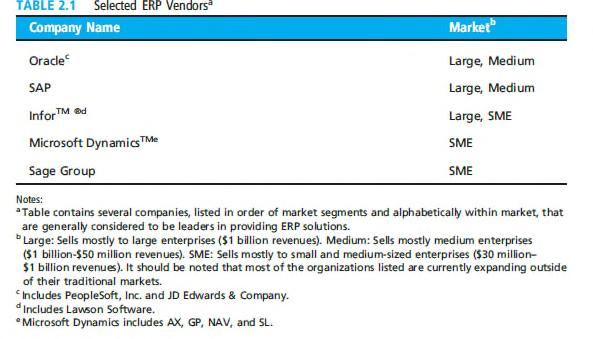
ENTERPRISE RESOURCE PLANNING (ERP) SYSTEMS
(SLIDE 3 OF 8)
Third-party add-on modules:
Customer relationship management (CRM) software: Builds and maintains customer-related database.
Customer self-service (CSS) software: Allows customers to complete tasks without the help of an organization’s employees.
Sales force automation (SFA) software: Automates sales tasks such as order processing and tracking.
ENTERPRISE RESOURCE PLANNING (ERP) SYSTEMS
(SLIDE 4 OF 8)
Supply Chain Management (SCM) software: Enables the steps in the supply chain including demand planning, inventory acquisition, manufacturing, distributing and selling.
Product Lifecycle Management (PLM) software: Manages product data from design through manufacturing and ending in the disposal of a product. ©
ENTERPRISE RESOURCE PLANNING (ERP) SYSTEMS
(SLIDE 5 OF 8)
Supplier Relationship Management (SRM) software: Manages the interactions with organizations that supply the goods and services to an enterprise; includes procurement and contract management.
ENTERPRISE RESOURCE PLANNING (ERP) SYSTEMS
(SLIDE 6 OF 8)
Third-party modules are connected to ERP systems using middleware (software for connecting two or more software applications or modules):
Application programming interface (API) is provided by the application developer.
Enterprise application integration (EAI) combines processes, software, standards, and hardware to link two or more systems together, allowing them to act as one.
ENTERPRISE RESOURCE PLANNING (ERP) SYSTEMS
(SLIDE 7 OF 8)
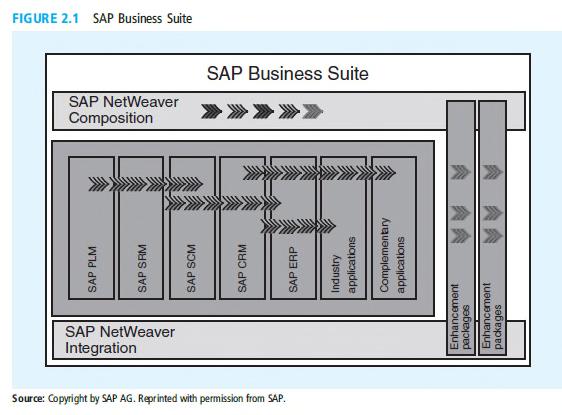
ENTERPRISE RESOURCE PLANNING (ERP) SYSTEMS (SLIDE 8 OF 8)
Business process management (BPM)
Takes into account modeling, automating, managing, and optimizing business processes, including:
A design environment for modeling and documenting business processes targeted at improvements.
Conversion of manual processes to automated processes.
Implementation of data entry forms that prevent error.
Engine to facilitate change.
Monitoring to enable process improvement and optimization.
ENTERPRISE SYSTEMS VALUE CHAIN
(SLIDE 1 OF 2)
A value chain is a chain of activities performed by an organization that transform inputs into outputs valued by the customer.
An organization creates a competitive advantage to creating more value for customers than its competitors.
Organizations create value by performing activities at lower cost or enhancing differentiation of products or services.
ENTERPRISE SYSTEMS VALUE CHAIN
(SLIDE 2 OF 2) © 2018 Cengage Learning. All Rights Reserved. May not be copied, scanned, or duplicated, in whole or in part, except for use as permitted in a license distributed with a certain product or service or otherwise on a password-protected website for classroom use.
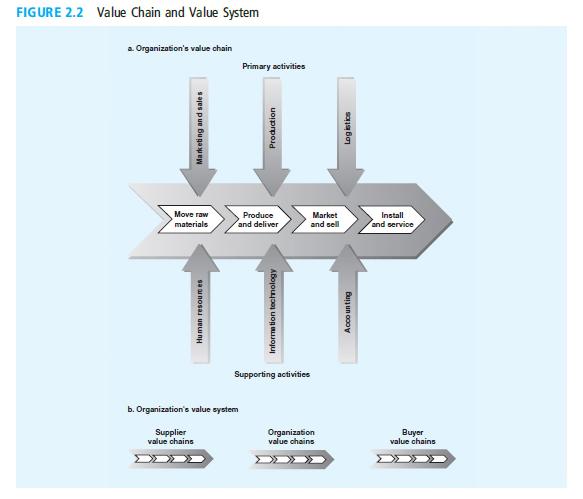
THEVALUE OF SYSTEMS INTEGRATION
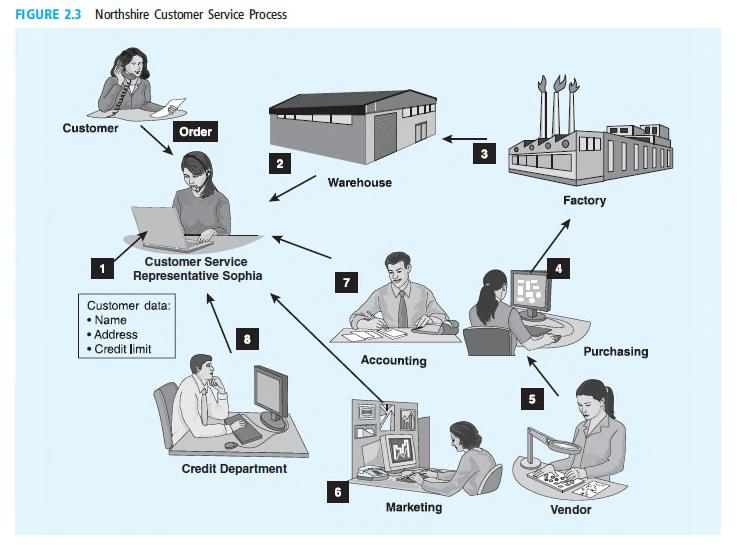
© 2018 Cengage Learning. All Rights Reserved. May not be copied, scanned, or duplicated, in whole or in part, except for use as permitted in a license distributed with a certain product or service or otherwise on a password-protected website for classroom use.
THE PROBLEM
When a call is received, Lanni needs to know if it is from a customer in good standing.
If so, Lanni needs to be able to tell the customer when they will receive the item (available to promise or ATP).
Without an integrated system, it is a long process that could take a day or more.
THE SOLUTION
Integrate disaggregated processes into an enterprise system.
Enterprise system establishes ATP (available to promise) by determining availability.
System automatically determines price and customer creditworthiness.
ADDITIONAL VALUE
Integrated information systems provide additional value by improving consistency, completeness, and accuracy.
Without integrated information systems, organizations have difficulty managing on a day-to-day basis and being successful in the long run.
© 2018 Cengage Learning. All Rights Reserved. May not be copied, scanned, or duplicated, in whole or in part, except for use as permitted in a license distributed with a certain product or service or otherwise on a password-protected website for classroom use.
ENTERPRISE SYSTEMS SUPPORT FOR ORGANIZATIONAL PROCESSES
An information system supports the functioning of an organization in several ways:
It facilitates the functioning of the organization’s operations.
The information system retains records about business events that have occurred.
The information system stores data that is useful for decision making.
©
Cengage
CAPTURING DATA DURING BUSINESS EVENTS
Data collected and stored should relate to the four W’s:
The who relates to all individuals and organizations that are involved in the event (sometimes called agents).
The what relates to all resources exchanged due to the event.
The where relates to the locations at which (1) the event takes place, (2) exchanged resources reside before and after the event, and (3) the agents are during the event.
The when relates to the time periods involved in completion of the event including future exchanges of resources. © 2018 Cengage Learning. All Rights Reserved. May not be copied, scanned, or duplicated, in whole or in part, except for use as permitted in a license distributed with a certain product or service or otherwise on a password-protected website for classroom use.
ENTERPRISE SYSTEMS DATA FACILITATE FUNCTIONING
OF THE ORGANIZATION’S OPERATIONS (SLIDE 1 OF 3)
A character is a basic unit of data.
A field (single cell in a table) is a collection of related characters that comprise an attribute.
A record (a row in a table) is a collection of related data fields (attributes) that belongs to a particular entity or event.
A table (or file) is a collection of related records (sometimes called entity/event instances).
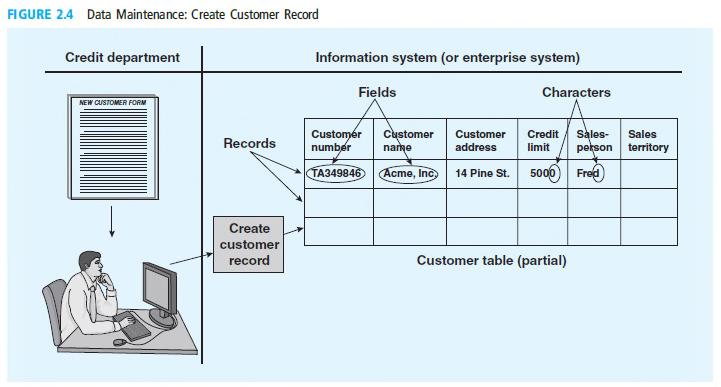
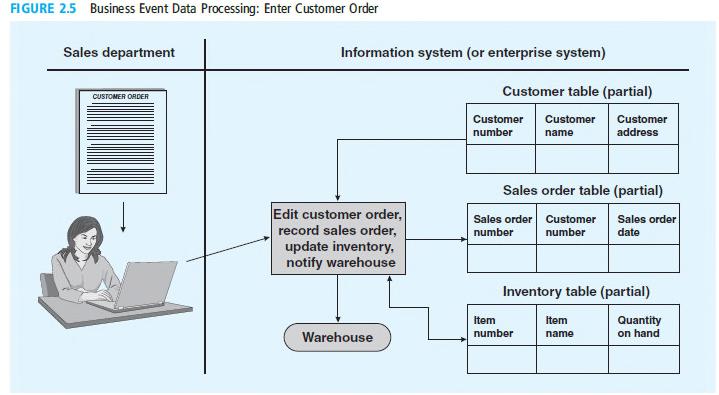
ENTERPRISE SYSTEMS RECORD THAT BUSINESS EVENTS HAVE OCCURRED
As the business event progresses, the information system must capture the multifaceted data to track the progression of the process.
All of the data that are required for the sales, billing, purchasing, and general ledger functions are captured and available in a typical information system.
With an enterprise system, the data are linked together.
ENTERPRISE SYSTEMS STORE DATA FOR DECISION MAKING
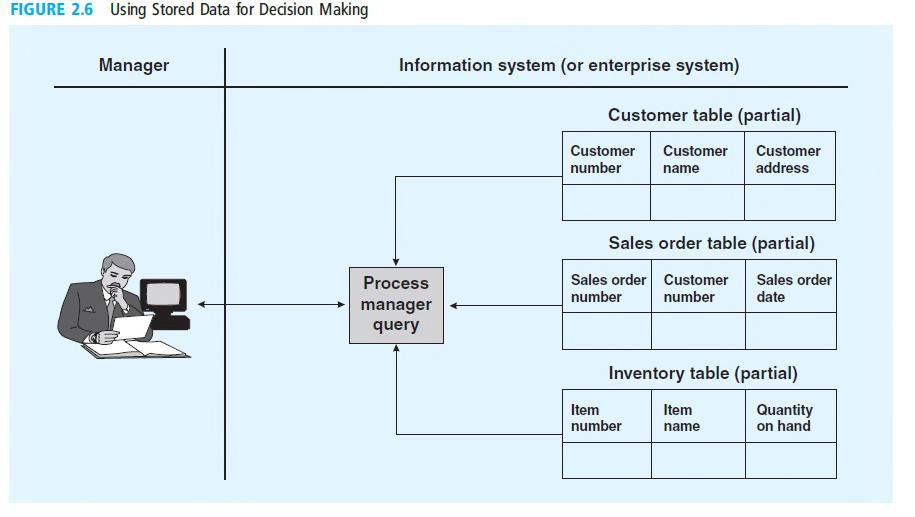
MAJOR ERP MODULES
SALES AND DISTRIBUTION
Three major steps in the SD process:
Order entry
Shipment
Billing
Connections to:
Materials management module (MM)
Financial accounting module (FI)
Controlling module (CO)
MATERIALS MANAGEMENT
Acquisition of goods from vendorsand management of the goods while they are in stock:
Preparing and recording a purchase order
Recording the vendor’s invoice
Interacts with: Sales and distribution module (SD)
Financial accounting module (FI)
Controlling module (CO) © 2018 Cengage Learning. All
FINANCIAL ACCOUNTING
Plays a central role in the SAP system.
Incorporates data from other modules into general ledger accounts and external financial statements.
Includes accounts receivable and accounts payable functions to record and manage that data directly and to complete events begun in the SD and MM modules.
CONTROLLING AND PROFITABILITY ANALYSIS
Often called Controlling and Profitability Analysis (CO/PA).
Handles internal accounting, including: Cost center accounting Profitability analysis for sales, activity-based accounting Budgeting
HUMAN CAPITAL MANAGEMENT
Managed in SAP by the Human Capital Management (HCM) module.
Module includes functions related to:
Recruitment
Management and administration of personnel
Payroll processing
Personnel training
Travel
Maintains data related to benefits, training, and work shifts.
© 2018 Cengage Learning. All Rights Reserved. May not be copied, scanned, or duplicated, in whole or in part, except for use as permitted in a license distributed with a certain product or service or otherwise on a password-protected website for classroom use.
ENTERPRISE SYSTEMS SUPPORT FOR MAJOR BUSINESS EVENT PROCESSES
Most organizations group their major business events into two processes:
The order to-cash (or revenue) process.
The purchase-to-pay (or expenditure) process.
ORDER-TO-CASH

ORDER-TO-CASH
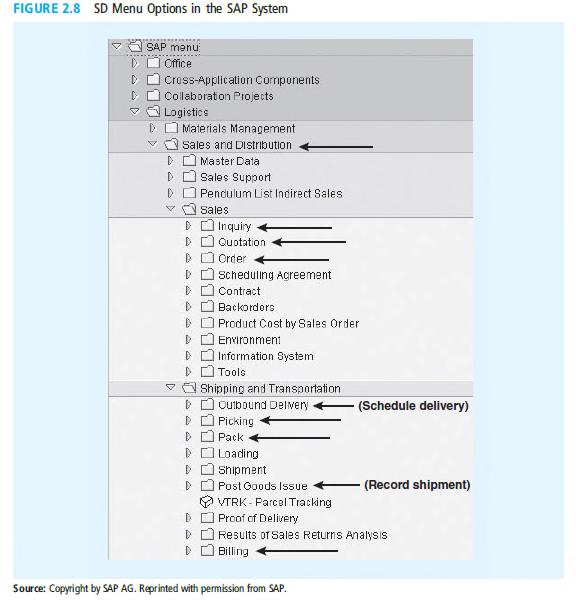
ORDER-TO-CASH
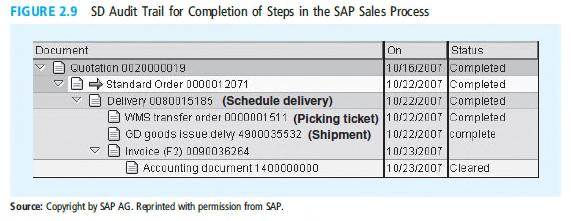
PURCHASE-TO-PAY (SLIDE 1 OF 3)
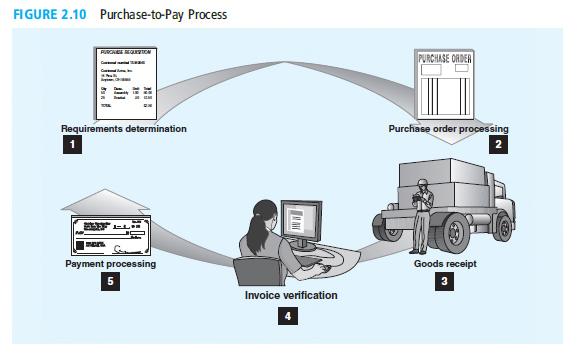
PURCHASE-TO-PAY (SLIDE 2 OF 3)
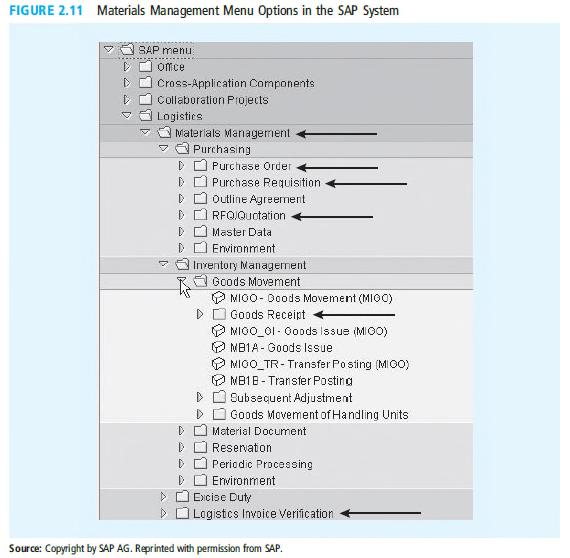
PURCHASE-TO-PAY (SLIDE 3 OF 3)
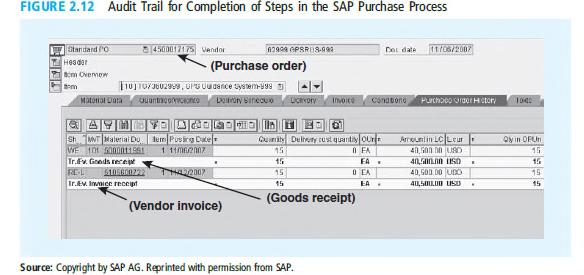
SUMMARY
(SLIDE 1 OF 4)
Enterprise systems achieve quality of information goals by:
Collecting data about business events.
Making that data available for use by interested and authorized parties.
Data should:
Help all users (relevance, understandability).
Make decisions (decision usefulness).
Analyze past events to make predictions about future events (predictive/feedback value). ©
SUMMARY
(SLIDE 2 OF 4)
An enterprise system’s central database:
Retains one version of data elements.
Uses data to verify the accuracy of new data elements.
Permits only authorized changes to the database.
Improves reliability, validity, and accuracy of the database.
SUMMARY
(SLIDE 3 OF 4)
Enforcement of data standards and business rules means:
Business events are handled consistently.
All relevant data is collected - completeness.
Collected data is verifiable and neutral.
All data is available in a timely manner.
The system facilitates the sharing of services for efficiency and consistency.
SUMMARY
(SLIDE 4 OF 4)
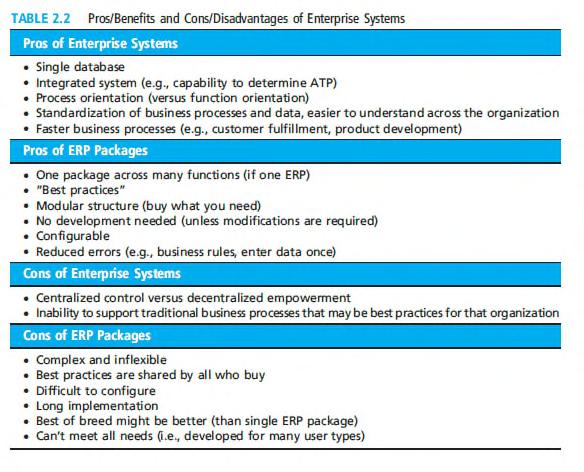
© 2018 Cengage Learning. All Rights Reserved. May not be copied, scanned, or duplicated, in whole or in part, except for use as permitted in a license distributed with a certain product or service or otherwise on a password-protected website for classroom use.
